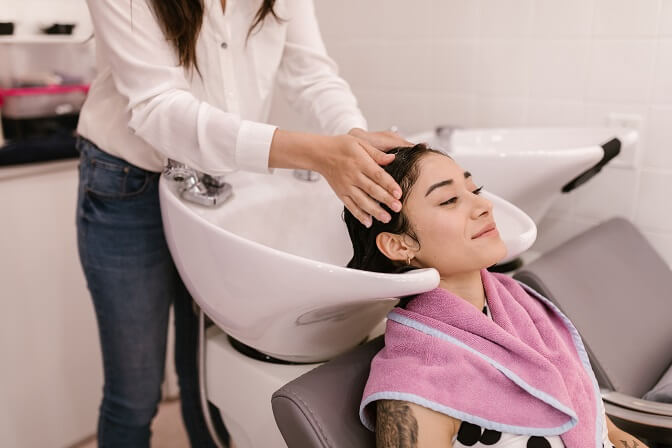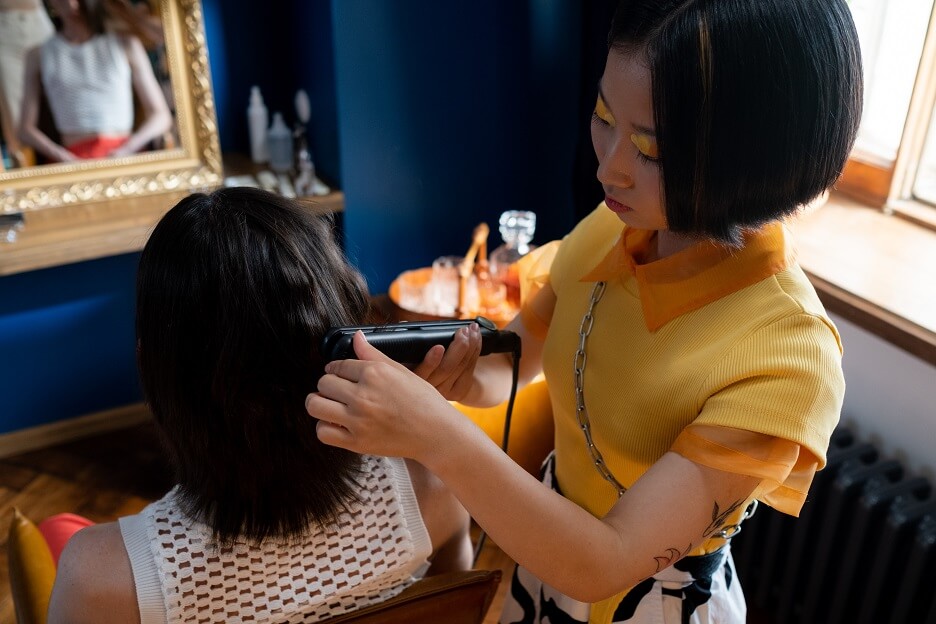Over the years, Dominican blowouts have garnered massive popularity in the natural hair space. However, this hair treatment has been around for a while now. When you want an occasional switch-up from your natural curly (or wavy) look, the Dominican blowout is a top natural styling technique.
We spoke with two haircare experts, Madison Dufour, a traveling cosmetologist, and Ghanima Abdullah, a Caribbean-based cosmetologist, for clarity on this straightening process, including how it’s done, its benefits and risks, and more.
What is a Dominican blowout?
The Dominican blowout is a natural hair straightening process that smooths the hair in just a few steps. Originating from the Dominican Republic, it’s effective on several different hair textures and can straighten the kinkiest curly hair without the use of damaging chemicals.
Most Dominican-owned hair salons offer this as a service. The straightening technique produces silky straight hair with lasting shine and a whole lot of bounce. It’s a reliable option for taming frizzy hair. However, achieving this look requires significant amounts of heat, which is the biggest drawback.
On average, Dominican blowouts can last for weeks. Madison Dufour estimated that some “might last six to eight weeks if carefully maintained, [while] others might last several months.”
One’s hair texture also comes into play when gauging the longevity of this style. For instance, someone with curly hair may convert back to their original texture sooner than someone with wavy or fine hair.
The Dominican blowout process
If you’re looking for a detailed explanation of the Dominican blowout process, we’ve got you covered. The process can take up to three hours in total. Many stylists have their own way of executing the technique, but we’ve provided an explanation of a generalized version of the treatment.
Step 1: Wash and deep condition

The treatment begins with cleansing the hair with a good wash and deep conditioning treatment. Some stylists use a clarifying shampoo to deeply clean the hair, which is effective for eliminating dirt, debris, and product buildup. Regardless of your hair’s level of cleanliness pre-treatment, a deep cleanse (followed by detangling) is an essential step of the blowout process. Most Dominican conditioners are formulated with a built-in protectant, so the hair can better endure the process, according to Ghanima Abdullah.
Step 2: Dry and section the hair
This step entails drying the hair and sectioning it with large rollers to stretch your curls. Your stylist will have you sit under a hooded dryer until your hair is fully dry. “This creates body and volume … and helps prevent damage because no direct heat is used on wet hair,” Abdullah said.
Step 3: Blow dry with a brush
Now comes the straightening part, which begins with applying a damage-preventing heat protectant to your strands. “The heat protectant can also protect from humidity and frizz,” Abdullah said.
From there, your stylist will blow dry the hair straight with a high-wattage hair dryer and round brush. “Round brushes create tension to pull the hair completely straight … [and] also create body,” Abdullah said.
The goal of this step is to get your hair as straight as possible, allowing stylists to minimize the use of a flat iron. Don’t be alarmed if it gets a little smoky during this step with the blow dryer. It’s a normal part of the process.
Step 4: Flat iron and wrap
This is an optional step, but your stylist may deem it necessary if your hair needs additional straightening. A flat iron can help iron out any kinks to further smooth the hair. Before sending you home, your stylist may also wrap your hair in a circular motion to preserve the style.
Dominican blowouts vs. silk presses
The Dominican blowout and silk press share many similarities. However, they aren’t the same. Both techniques produce the same result: silky straight hair without the use of harsh chemicals.
The type of heat used is what ultimately differentiates the two. A silk press requires direct heat on wet hair on top of flat ironing. “When wet hair is blowdried with direct heat, it creates bubbles in the hair shaft as the water literally boils within,” Abdullah said. “This creates damage and breakage.”
Although silk presses last longer, it’s wise to alternate styles and give your hair an occasional break from the heat. With a Dominican blowout, the straightening step begins on dry hair, which is less damaging. Hair can also achieve more volume and bounce with a Dominican blowout.
Do Dominican blowouts damage your hair?
Hairstylists generally consider Dominican blowouts safe for natural hair. The high heat used during the process is the biggest threat to your hair’s health. Excessive heat leads to eventual breakage and damage to one’s hair cuticles.
“If you consistently use high heat in your blowouts, which is necessary to straighten natural hair, you’ll find that the protein in your hair gets stretched permanently, and the hair won’t revert,” Abdullah said. This explains why stylists recommend getting the treatment no more than once a month. According to Abdullah, this frequency will give the hair a chance to de-stretch the hair bonds or revert gradually.
A cultural hair phenomenon
If you want bone-straight hair without chemically damaging your curls, you can’t go wrong with the occasional Dominican blowout. At Dominican-owned hair salons, it’s a cultural styling technique that’s been around for generations, and its relevance in mainstream hair culture only grows by the day. Like every hair treatment, it has its pros and cons, but the main thing to keep in mind with Dominican blowouts is that moderation is key for maintaining healthy hair.





